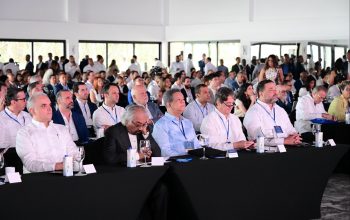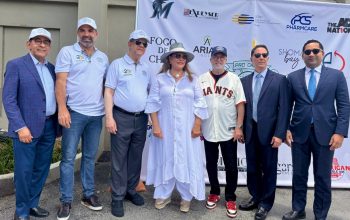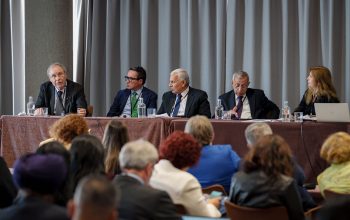news
“Pedro the Great: From Manoguayabo to Cooperstown”, an article by Dr. Leonel Fernández
January 19, 2015
Under the direction of Felipe Rojas Alou at the Montreal Expos, the Dominican pitcher Pedro Martínez vaulted to stardom, winning the first of his three Cy Young Awards.
In the Bible, Peter was a simple fisherman on the Sea of Galilee, who for his loyalty to the teachings of Jesus of Nazareth, the son of God, became the prince of the Apostles and the first Pope of the Catholic Church.
Peter the Great, or Peter I, for
his part, was one of the most outstanding governors of Russia, member of the Romanov dynasty, namesake of the city of Petrograd, now St. Petersburg.
But there’s another Peter, who based on his talent, effort, and dedication, shared a lovely gift with his people this past January 6, on Three Kings Day: his inauguration to the Cooperstown Baseball Hall of Fame.
We’re talking, of course, about Pedro Jaime Martínez, Major League star
pitcher who, owing to his dominant style and spectacular accomplishments on the pitching mound, became the second Dominican to achieve that highest distinction after the Monster from Laguna Verde, the mythic Juan Marichal.
This Pedro the Great, as we know, was born in a humble home in the modest community of Manoguayabo, where the passion for the nation’s favorite pastime—baseball—was infectious. His father, Pablo Jaime, was also a stand-out player in his day,
playing alongside no less a star than Felipe Rojas Alou, from the team Cami, in the Farmers’ League.
Pedro Jaime was a pitcher. He could throw a disconcerting curveball and a straight pitch that left a smoke trail. He caught the attention of several big league scouts and at one point even received an offer to sign.
Thrilled, he told his mother, Pedro’s grandmother Doña Julita, who with absolute certainty and conviction replied:
“Well, damn, have you seen you canlive off the ball!”
Baseball in the blood
Pablo Jaime didn’t make it to the big leagues, nor did his brothers Rafael and Pempén (Pedro’s uncles), who practiced with him, but three of the four boys born to Pablo and his wife, Leopoldina Martínez, would indeed make it that far.
The first was Ramón Jaime Martínez, the eldest, who for 13 seasons
distinguished himself in the uniform of the Los Angeles Dodgers.
The second, of course, was Pedro; but the third, whom we know little about, was Jesús, who also made an appearance, albeit a short one, as a pitcher in the Major League stadiums. The fourth son, Nelson, who they called Capi (for Captain), played short stop, and is a real mystery, as although they say he was the best of them all, the big leagues never got him.
These four boys, since they
were kids, would leave their sisters Luz María and Ana Delia at home early in the day, and set off alongside their cousins and a group of friends to find someplace to play ball.
They played in Palavé, in Las Caobas, in Los Alcarrizos, and on a piece of land they found near Agro Delta. They marked the bases with oranges, pitched with stones wound up in thread, and batted with broomsticks.
At night, they got together with their dads and uncles to talk
baseball, shell peas, play cards, and listen to the family’s favorite radio show: 100 Songs and a Million Memories.
Over time, the boys would manage to join the League of Rudy Ramírez, which would eventually become the San Miguel Reales, and there they began to play in a more organized way.
Pedro received his first uniform, which sported the number 9, and he still confesses to having slept with it on the first night.
When
Ramón moved on to the Senior League and then Class A, he became his brother’s idol. He wanted to be like him. Then, under the conditions of his contract, Ramón was signed and declared a prospect by the Dodgers. They assigned him Eleodoro Arias as his pitching coach, who would become a determinant figure in Pedro’s own evolution as a pitcher.
Eleodoro, who had been a member of the national team, gave instructions to Ramón on the art of pitching. Pedro,
for his part, tried to stay close to hear what they were telling his big brother, and then practice it for himself.
Like this, at age 13, Pedro, who already threw a straight ball at 75 miles per hour, learned to pitch the curve, the slider, and the changeup, as well use different arm slots: over-the-top, three-quarter, and sidearm.
He practiced everywhere, all the time, even in front of the mirror in his house. And thus over time he developed complete
power and control over all those pitches.
Naturally, from there he burned through all the leagues. There was no batter who could best him. He was too much for other players his own age; and thus it was that in 1988, at 17 years old, he was signed, alongside his brother Ramón, by the legendary LA Dodgers.
Road to glory
He played four seasons in the Minor Leagues, passing through places like Great Falls, Montana;
Bakersfield, California; San Antonio, Texas; and Albuquerque, New Mexico.
Wherever he went, he shined.
He was the best pitcher of his day in the Minor Leagues. But at the beginning, in Montana, something happened that nearly ruined his career: he had an altercation with the manager, who spoke to him rudely.
Pedro packed his bag to go back to the Dominican Republic, and only decided against it when Ms. Shelly Haffner, owner of the guesthouse
where he was staying (and whom he affectionately referred to as Mamá Conchita), managed to beg him and convince him to stay.
When he moved up into the Major Leagues, Pedro would again be tempted to abandon his career and throw everything away. It was at the end of the 1992 season. He’d been on the Dodgers roster for three weeks already and no one had paid him a bit of attention, not saying even a word. They ignored him completely. They just saw him as
Ramón’s brother.
He spent the games sat in the bullpen. They didn’t even ask him to warm up. He felt so disrespected that finally, on the day of his Major League debut, as a relief pitcher, he was more incensed than pleased.
Still, he struck out the first three batters who took the plate in front of him.
The following year, in 1993, he was the best pitcher in the Grapefruit League. But when the season started, they
put him down to Triple A. That day he cried and, for the third time, contemplated a return flight back to the Dominican Republic.
Luckily, he didn’t do it. Within a short time one of the team’s star pitchers was injured and the star from Manoguayabo was called in as an urgent replacement in the Major League team. He had a brilliant rookie season, with 10 wins and 3 losses.
But the Dodgers thought Pedro was neither tall enough nor
heavy enough to hold up in the big leagues. Thus at the end of the season they opted to send him to the Montreal Expos.
The change turned out to be a blessing. From the indifference and lack of appreciation at the Dodgers he moved on to the affection and esteem of the Expos manager, his father’s old friend, the great Felipe Rojas Alou. Under Felipe’s guidance, Pedro Martínez vaulted to stardom, winning the first of his three Cy Young Awards.
Years later, when the Expos could no longer pay him what he was worth, he went to the Boston Red Sox. There, alongside David Ortíz and Manny Ramírez, two other titans, he made history by breaking the Curse of the Bambino to crown the Red Sox, after 86 years, with the title of 2004 World Series Champions.
During his 18-year Major League career, which would end with the New York Mets and the Philadelphia Phillies, Pedro Jaime Martínez, sporting the number 45 on his
back, won 219 victories, struck out more than 3,000 batters, and played on eight different All-Star teams.
He became a legend. He became, plain and simple, Pedro the Great.
Of course, with his remarkable big league success, and without quite intending to, Pedro won an even greater triumph: making his grandmother, Doña Julita, get her prediction wrong.
Now, with his wife Carolina Cruz, whose father and brothers were also famous
baseball players, Pedro says he’s found stability and balance in his life; and from this love have sprung Pedro Pablo and Isaías, who at ages 13 and 14, respectively, already also pitch at 75 mph and are the image of their father.
Related links:
http://leonelfernandez.com/articulos/pedro-el-grande-de-manoguayabo-cooperstown/






